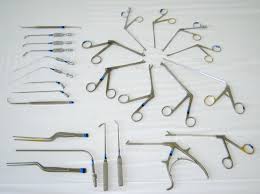The calibre and assortment of equipment that medical practitioners employ greatly influence the accuracy and efficacy of ENT therapy.
Overview:
ENT Instruments in UK The diagnosis and treatment of several ailments pertaining to influencenodules. These delicate human body regions greatly aid the specialty of ENT medicine. The UK has witnessed a notable surge in the need for superior ENT tools, mostly due to technological progress in medicine and a growing emphasis on patient care.
This thorough reference ENT Instruments in UK examines the many kinds of ENT instruments that are available in the UK, their applications, and the things to think about when selecting the appropriate equipment for clinical practice.
ENT Instrument Types:
Otoscopes and diagnostic instruments:
An otoscope An otoscope is a basic diagnostic instrument that ENT professionals use to look at the eardrum and canal. Its light source and magnifying lens enable a close-up view of the inside components of the ear. For the diagnosis of ear infections, eardrum perforations, and other ear diseases, otoscopes are indispensable.
A rhinoscope:
The sinus chambers and nasal passageways are examined with a rhinoscope. This device, which has a light and a lens, aids in the diagnosis of sinus infections, polyps, and obstructions in the nose. To meet a range of diagnostic requirements, rhinoscopes are available in varied sizes and styles.
Laryngoscope:
The larynx, or voice box, and the vocal cords are examined with a laryngoscope. It is crucial for the diagnosis of laryngitis, various voice problems, and vocal cord nodules.Flexible laryngoscopes are more often utilized since they are more comfortable and user-friendly than stiff ones.
Instruments for surgery:
Small-scale debrider:
A motorized tool called a microdebrider is used in ENT procedures to precisely remove soft tissue, such polyps or tumors. It allows surgeons to accurately execute minimally invasive treatments by combining suction with a revolving blade.
Forceps for the Sinus:
Specialized instruments used in sinus procedures are called sinus forceps. They support the process of reaching into the sinus cavities and extracting tissue or foreign objects. These forceps are made for specific surgical purposes and are available in a variety of sizes and forms.
Tonsil Snare:
Tonsils are removed during tonsillectomy treatments using the tonsil snare. It is made out of a wire loop that surrounds the tonsil, making it possible for the surgeon to securely cut and remove it. By ensuring a precise and clean excision, this tool reduces bleeding and surgical problems.
Medical Devices:
Speculum Nasal:
Widening the nostrils using a nasal speculum facilitates improved access for medical or diagnostic operations. It is a straightforward yet crucial instrument for every ENT office, making inspections and small nasal cavity procedures easier.
Syringe for the ears:
To remove wax or foreign objects from the ear canal, an ear syringe is used for irrigation. It is a crucial therapeutic tool, particularly when dealing with impacted earwax, which can be uncomfortable and result in hearing loss.
Tympanometer:
One tool for assessing middle ear function is the tympanometer. It gauges the eardrum’s movement inreaction to variations in air pressure, aiding in the identification of diseases such as middle ear infections, otitis media, and eustachian tube dysfunction.
Considerations for Selecting ENT Instruments:
Durability and Quality
When it comes to ENT tools, quality and longevity are crucial. High-quality materials like titanium or stainless steel are used to make instruments that are long-lasting and reliable. Additionally, superior devices lower the chance of problems during surgeries and improve patient outcomes.
Comfort and Ergonomics:
Instruments with ergonomic designs are essential for the comfort and productivity of medical professionals. Easy-to-handle and operate instruments enhance accuracy during procedures and lower the danger of hand fatigue.
Maintenance and Sterilization:
ENT equipment has to be simple to maintain and sterilise. Tools that are resistant to repeatedFor the purpose of preserving sterility and guaranteeing patient safety, sterilization procedures that do not degrade are perfect.
Price and Availability:
Availability and cost are further crucial considerations. Healthcare institutions must strike a balance between budgetary limits and the importance of investing in high-quality tools. Furthermore, easily accessible tools guarantee that repairs and replacements may be completed on time without interfering with medical services.
Supplier Standing:
To acquire dependable and superior instruments, select a trustworthy source. Strong performance histories in the medical sector increase the likelihood that suppliers will deliver high-quality products and first-rate customer service.
Leading UK providers of ENT instruments:
Timesco Healthcare Ltd:
In the UK, Timesco Healthcare Ltd. is a top provider of premium medical equipment. They provide an international selection of ENT devices, renowned for their dependability and accuracy. A lot of medical professionals choose Timesco because of their dedication to innovation and client satisfaction.
Medical Systems Olympus:
Olympus Medical Systems is renowned for producing cutting-edge medical diagnostic and therapy equipment. Modern otoscopes, rhinoscopes, and laryngoscopes from their ENT line are made to last and work very well.
Medtronic:
As a leading provider of medical technology worldwide, Medtronic provides an extensive selection of ENT surgical tools. Their goods are renowned for their excellent quality, creative designs, and capacity to enhance patient outcomes.
Braun Medical Ltd., B:
A large range of ENT devices, including surgical and diagnostic equipment, is offered by B. Braun Medical Ltd. They are renowned for their dedication to excellence and security, guaranteeing access to the best equipment for their practice is available to healthcare providers.
Conclusion:
ENT tools are essential for the detection and management of disorders affecting the ears, nose, and throat. Healthcare practitioners in the UK have access to a large variety of reliable providers’ high-quality tools. Medical professionals may make sure they have the greatest resources to give patients the best treatment possible by taking into account aspects like cost, supplier reputation, quality, ergonomics, sanitation, and cost. Investigate the best vendors and equip your ENT clinic with the best tools available.




